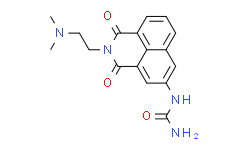| 中文名称: | UNBS5162 一键复制产品信息 | ||||
|---|---|---|---|---|---|
| 英文名称: | UNBS5162 | ||||
| 别名: | N-[2-[2-(二甲基氨基)乙基]-2,3-二氢-1,3-二氧代-1H-苯[de]异喹啉-5-基]脲R;UNBS-5162 抑制剂 1-(2-(2-(dimethylamino)ethyl)-1,3-dioxo-2,3-dihydro-1H-benzo[de]isoquinolin-5-yl)urea | ||||
| CAS No: | 956590-23-1 | 分子式: | C17H18N4O3 | 分子量: | 326.35 |
| CAS No: | 956590-23-1 | ||||
| 分子式: | C17H18N4O3 | ||||
| 分子量: | 326.35 | ||||
基本信息
|
产品编号: |
U10068 |
||||
|
产品名称: |
UNBS5162 |
||||
|
CAS: |
956590-23-1 |
储存条件 |
粉末 |
-20℃ |
四年 |
|
|
|
||||
|
分子式: |
溶于液体 |
-80℃ |
6个月 |
||
|
分子量 |
326.35 |
-20℃ |
1个月 |
||
|
化学名: |
1-(2-(2-(dimethylamino)ethyl)-1,3-dioxo-2,3-dihydro-1H-benzo[de]isoquinolin-5-yl)urea |
||||
|
Solubility (25°C): |
|||||
|
体外:
|
DMSO |
17mg/mL (52.09mM) |
|||
|
Ethanol |
Insoluble |
||||
|
Water |
Insoluble |
||||
|
体内(现配现用): |
|
||||
|
<1mg/ml表示微溶或不溶。 |
|||||
|
普西唐提供的所有化合物浓度为内部测试所得,实际溶液度可能与公布值有所偏差,属于正常的批间细微差异现象。 |
|||||
|
请根据产品在不同溶剂中的溶解度选择合适的溶剂配制储备液;⼀旦配成溶液,请分装保存,避免反复冻融造成的产品失效。 |
|||||
制备储备液
|
浓度
溶液体积 质量 |
1mg |
5mg |
10mg |
|
1mM |
3.0642mL |
15.3210mL |
30.6419mL |
|
5mM |
0.6128mL |
3.0642mL |
6.1284mL |
|
10mM |
0.3064mL |
1.5321mL |
3.0642mL |
|
50mM |
0.0613mL |
0.3064mL |
0.6128mL |
生物活性
|
产品描述 |
一种广谱的趋化因子配体 CXCL 拮抗剂,具有抗肿瘤活性。 |
|
靶点 |
CXC |
|
体外研究 |
UNBS5162 is a pan-antagonist of CXCL chemokine expression and exhibits weak antiproliferative activity against human cancer cell lines with mean IC50 of 17.9µM.UNBS5162 markedly impairs PC-3 tumor cell growth kinetics,without inducing senescence,whereas the reverse feature is observed with respect to DU-145 cells.UNBS5162 is cytotoxic to a range of human cancer cell lines including glioblastoma (Hs683 and U373MG),colorectal (HCT-15 and LoVo),non-small-cell lung (A549) and breast (MCF-7),with IC50s of 0.5-5µM.UNBS5162 also markedly increases the levels of expression of LC3-I and LC3-II in human cancer cells. UNBS5162 displays no anti topoisomerase II activity. Moreover,UNBS5162 induces cancer cell death through lysosomal membrane permeabilization (LMP) in PC3 prostate cancer cells but not in U373 glioblastoma cells,with this LMP process occurring as an UNBS5162-induced decrease in Hsp70 expression.UNBS5162 inhibits the proliferation of esophageal cancer squamous cells via the PI3K/AKT signaling pathway.UNBS5162 downregulates the protein expression of proteins associated with the PI3K/AKT signaling pathway, including the levels of phosphorylated (p)-AKT,p-mechanistic target of rapamycin kinase,ribosomal protein S6 kinaseβ1 and cyclin D1. |
|
体内研究 |
UNBS5162 (20mg/kg,i.v.) increases the therapeutic benefits of taxol in vivo in the orthotopic human PC-3 prostate cancer model. |
推荐实验方法(仅供参考)
|
细胞实验: |
|
|
细胞系 |
PC-3和DU-145细胞 |
|
浓度 |
10µM |
|
处理时间 |
72h |
|
动物实验: |
|
|
Mice Orthotopic xenografts are obtained by injecting 2.5×106 human PC-3 or DU-145 cells into the prostate of 6-week-old male nu/nu mice (n=9 animals per treatment group).All grafts are performed under anesthesia [saline/Rompun/Imalgene;5:1:1 by volume].The end point in these orthotopic experiments is the survival period of the tumor-bearing mice after the administration of UNBS3157,UNBS5162,or reference anticancer agents (taxol,mitoxantrone, and amonafide).However,for ethical reasons,animals are killed when 20% of body weight have been lost compared to that determined at the time of tumor grafting.All animals are weighed three times a week.Autopsies and histologic diagnoses are performed on each mouse to confirm the presence of tumor development; 100% is achieved.In the case of UNBS5162 experiments in the PC-3 model,after the sacrifice of animals,tumors are removed from both drug-treated [10mg/kg,intravenous (i.v.)] and vehicletreated mice,fixed in buffered formalin,embedded in paraffin,and 5-µm-thick sections taken.These histologic slides are then stained with hematoxylin and eosin for blood vessel counts. |
|
本计算器可帮助您计算出特定溶液中溶质的质量、溶液浓度和体积之间的关系,公式为:
质量 (g) = 浓度 (mol/L) x 体积 (L) x 分子量 (g/mol)
摩尔浓度计算公式
用本工具协助配置特定浓度的溶液,使用的计算公式为:
开始浓度 x 开始体积 = 最终浓度 x 最终体积
稀释公式
稀释公式一般简略地表示为:C1V1 = C2V2 ( 输入 输出 )








